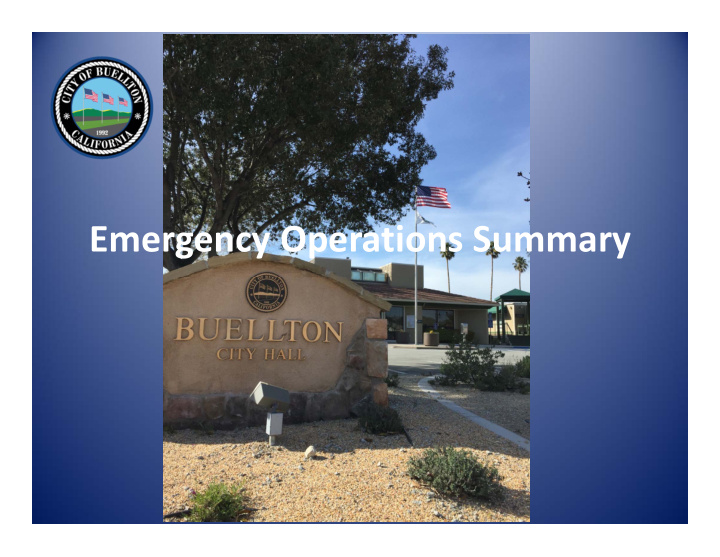



Emergency Operations Summary
Emergency Preparedness • Goal is to protect – Life – Property – Environment
National Incident Management System (NIMS) • Common Terminology • Modular Organization • Integrated Communications • Unity of Command • Consolidated Action Plans • Manageable Span of Control • Designated Incident Facilities • Resource Management
Five NIMS Functions • Management • Operations • Planning/Intelligence • Logistics • Finance
City Organizational Chart
Organizational Levels • Federal – State • OES Region – Operational Area (County) » Local Government (City) • Field (Incident Command)
Four Phases of Emergency Management • Mitigation • Preparedness • Response • Recovery
Emergency Operations Center (EOC) • Primary EOC • Activations Levels – Planning Department – Level 1 – Minimum Offices Staffing – Level 2 – Functional • Alternate EOC Position Staffing – City Hall – Level 3 – Full Staffing
City Resources • Emergency Management Plan • EOC Generator • Satellite Phone • Police and Fire Radios • Two CERT Trailers • Shelter Locations – Jonata School – Oak Valley School • Extra On ‐ Call Staff when Events Predicted – Storms
City Staff • Emergency Manager • Operations Leader – Public Works – City Manager Director/Sheriff Lt./Fire • EOC BC Manager/Emergency • Planning Leader Coordinator/PIO/Liai – Planning Director son/Safety • Logistics Leader – City Clerk – Recreation Coordinator • Finance Leader – Finance Director
Mayor and Council Duties • Obtain Briefings by the City Manager or Designee • When Available Report to a Designated Location for Information Updates – Council Chambers • With the Assistance of the City Clerk (PIO), Survey the Impacted Areas of the City
Mayor and Council Notifications • You will receive: – Updates on current conditions by the City Manager or Designee – Instructions on where and when incident briefings are planned • The City Clerk (PIO) will schedule interviews with the media for the Mayor • Before answering questions from the citizens or media, make sure that you have been briefed on the current information
Basic Media Rules • Avoid Speculation – tell only what you know • If you don’t know an answer to a question, say so, and offer to find the answer and get back to them • Avoid making promises
Media Communications • Things you can say: – Our emergency operations center is open and staffed… – First responders are aware of the situation and actively working on it… – I have been given our current situation, which is… – Can I get back to you within an hour with more information… • Things not to say: – I don’t know – No comment – Don’t make promises
Declaring a Disaster • When life, property or the environment are threatened and City resources have been depleted… – Can only be proclaimed by the governing body of the City or by an official designated by ordinance – Cannot remain in effect for more than seven days without ratification – If there is a need to continue the proclamation, City Council will meet every 14 days
Partners • County Office of Emergency Management • County Sheriff and Fire • Neighboring Cities • State Office of Emergency Services • Red Cross • VOAD (Volunteer Organizations Active in Disasters)
Personal Responsibility • Have an emergency kit ready and current with supplies • Family plans, including meet ‐ up locations • Prepare your home, office, and car • Develop a communications plan with your family • Staff are expected to perform their assigned responsibilities during a disaster after making sure their family is safe
Recommend
More recommend